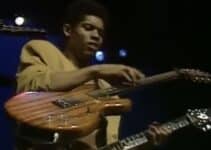In this lesson, we welcome back Steve Morse to wow us with a performance over Guitar Techniques editor Jason Sidwell’s track, The Dude Ranch. With a straight eighth-note rock feel and a tempo of 110bpm, it has a steady groove with space for lots of colourful rhythmic and melodic phrasing.
To begin his solo, Steve plays with strong blues phrasing in the style of players such as Albert King. To keep the delivery authentic plenty of space is left between the phrases. From a melodic perspective, Steve alternates between F# Major Pentatonic (F#-G#-A#-C#-D#) and F# Minor Pentatonic scales (F#-A-B-C#-E).
For the chorus he switches to C# Minor Pentatonic (C#-E-F#-G#-B), and elaborates on the C# Minor Pentatonic shapes using extra chromatic notes. Steve uses chromatic notes throughout the solo – it’s been a trademark throughout his career – to link up the chord tones and add extra non-diatonic spice.
To take us into verse 2 Steve plays an ascending phrase using pedal tones. The pedal note anchors the tonality; here the melody notes are played alternately against the pedal tone, and the semiquaver phrasing fits in nicely with the rhythm of the track. Steve is an expert alternate picker and this type of lick is a great workout for the picking hand (why not isolate it and use it as such?).
For verse two Steve delivers a pre-composed motif which provides a cohesive thread. Again the idea is based around F# Minor Pentatonic (F#-A-B-C#-E). Chorus two switches tonality once again and this time Steve shifts to D Major Pentatonic as his home base (D-E-F#-A-B). D Major Pentatonic contains the same notes as B Minor Pentatonic so feel free to think of it this way if you are more familiar with Minor Pentatonic fretboard shapes and positions.
Jason has written a middle eight for The Dude Ranch, and Steve cleverly negotiates the chords with another pre-composed idea. He says his inspiration for this was imagining the type of line that a horn section might play. To add energy and power, Steve naturally adds string bends and finger vibrato to these phrases. There follows a two-bar break in which he plays a lovely descending chromatic line and this brings us neatly into the final verse.
To begin the climax of our piece, Steve releases some tension by letting rip with some F# Blues scale licks (F#-A-B-C-C#-E), while to finish his solo he reaches for some ascending unison bends, which players like Jimi Hendrix and Eddie Van Halen used to great effect.
As Steve explains, the unison bends add power and you can also adjust their dissonance by adding finger vibrato to the bent note. This creates a spooky effect and a bit of extra thickness and voodoo.
Hopefully there will be a new technique, lick or phrase in here for you to perfect. If so, memorise it, tweak and alter it for use in your own solos. Once you have mastered some of these concepts, be encouraged to try your own solo over The Dude Ranch – we’ve included a full chord chart with which you can plan your lead assault. Have fun!
Chord Chart
Get the tone
Amp settings: Gain 8, Bass 7, Middle 7, Treble 6, Reverb 3
Steve used his blue Ernie Ball Music Man signature guitar. Bridge and neck pickup both get a lot of use so we suggest you do likewise. Steve has a general rule to even out his tone; above the 12th fret use the neck pickup, below the 12th fret use the bridge pickup. Any electric guitar will work well. Just dial up a clean sound for the start of the solo then switch to a rich overdriven tone with plenty of sustain. Add reverb to taste.
Steve Morse – The Dude Ranch
Intro [Bars 1-2] The intro section features a C7#9 sound from the band so Steve nails this down this by playing a C# root note.
Verse 1 [Bars 4 -15] In verse 1 Steve alternates between the F# Major Pentatonic (F#-G#-A#-C#-D#) and F# Minor Pentatonic scales (F#-A-B-C#-E. The phrasing is sparse and constructed in a musical, question and answer style fashion.
Keep an eye out for any A Natural notes (Minor 3rds over F# chords) as these can be bent slightly sharp – there’s no need to be exact, as you’re aiming to bend the note ‘to nowhere’ to give it more of a classic blues feel.
Chorus 1 [Bars 16-23] Here the scale of choice switches to C# Minor Pentatonic (C#-E-F#-G#-B). Steve uses chromatic notes throughout the solo to link up the chord tones and these also add extra colour. He demonstrates in his analysis how to bounce melodies off a pedal tone. The ascending lick in bar 23 is a good picking technique exercise and builds nicely into verse 2.
Verse 2 [Bars 24 -31] This section features an idea that groups together five notes. When this idea is repeated it means the next part of the pattern starts on the offbeat and this sets up a revolving syncopated accent.
Chorus 2 [Bars 32-47] For this section Steve works an ascending pattern into the melody. For the super high string bends of this section he uses his fourth finger to reach and fret the notes.
Being the smallest of our digits the fourth finger is the perfect choice when requiring accuracy in the cramped confines of this part of the neck. The other three fingers can be used to provide support, as of course the fourth finger, being the smallest, is also not the strongest.
Break [Bars 48-49] To take us back into verse 3 there is a pretty cool descending chromatic run to navigate. As already mentioned, Steve uses chromatic notes throughout the solo to link up the chord tones and to add tension and colour. This descending lick provides another good workout for the picking hand.
Verse 3 [Bars 50-end] Steve launches into the final straight with some cool F# Blues scale (F#-A-B-C-C#-E) licks before ending with some Hendrix-style unison bends. Bend the note on the third string until it matches the pitch of the fretted second string. Adding vibrato to the third string provides a cool dissonance.

